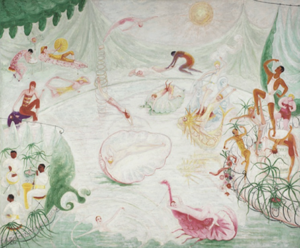Today’s post comes from Michael Cadenas, class of 2015 and Art Center student docent.

As a part of “The Artful Dodger” series of talks at the Frances Lehman Loeb Art Center, Marianne Begemann, Dean of Strategic Planning and Academic Resources, stepped out to the Sculpture Garden to highlight some of the works on view in her October 31 presentation, “The Experience of Sculpture.” As a professor of chemistry, Begemann departed from standard art discourse and delivered her unique outlook on two scultpures.
She began with a work by Toshiko Takaezu titled Asa-Kiri (Morning Mist). Takaezu, a ceramic artist and painter, crafted the spherical object of stoneware, which Begemann was delighted to talk at length about. She detailed its entire chemical process, from clay to the finished product, and even went as far as to lay out its differences from earthenware, a ceramic made from a similar, though not identical, process. Begemann’s care for underlining the work’s chemical and procedural features spoke perfectly to the multi-faceted nature of her interest in the experience of viewing sculpture: whereas someone else might absorb the work solely on the basis of its form, she perceives it at a molecular level as well.

Begemann’s interests, however, did not strictly lie in her fascination with the work’s chemical processes. In keeping with the name of the talk, she spoke also about how our experience of sculpture differs from our experience of other kinds of art. She pointed out sculpture’s difference from two-dimensional art and the way it demands a certain response from the viewer. Because a sculpture has an immediate physical presence within our environment, we subconsciously carve out a sense of its spatial relation to our own being. It’s length, width, and height allow us to compare the sculpture to our own stature, thus establishing a subtle but palpable connection with the work.
This differs from the experience of viewing a painting, for example, because forms within the frame are distorted to appear larger or smaller than they would be otherwise. What’s more, our ability to move around the sculpture differs greatly from our ability to maneuver around a two-dimensional work of art. Although we have no chance and no reason to get behind a painting, Begemann demonstrated how a person’s ability to move around the sculpture, look at it from different angles and, on some occasions, feel the work, satisfies our curiosity in a way a painting is unable to.

Alexander Archipenko (Ukranian, 1887 – 1964), Queen of Sheba, 1961, Bronze, On loan from Frances Archipenko Gray
Begemann ended her talk at Alexander Archipenko’s sculpture titled Queen of Sheba, an abstract representation of a traditional female form. Begemann concluded with an informative deliberation on bronze and other copper alloys in sculpture. Her brief meditation offered an invaluable understanding of sculpture’s transitory nature. Although it is invisible to the human eye, sculptures are in a steady state of transformation due to the unavoidable degradation of materials used. One can’t help but make a connection between this inevitability and our own mortality, establishing further the connection between the work and us.




